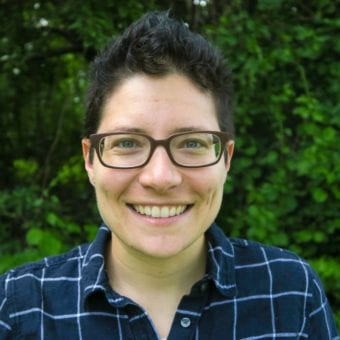Content updated on 03/29/24
When I first sought treatment for my eating disorder, I didn’t yet have the words to state that I was non-binary. I didn’t have the language to express what I was internally experiencing for years. My eating disorder allowed me to cover, avoid and control the parts of myself that I wasn’t ready to reveal to the world.
One thing we know about eating disorders is that they develop because of complex and multifaceted biopsychosocial factors. I’ve come to understand that my eating disorder was in part the result of this internal conflict between how society perceived me and how I actually wanted to be seen. It was also the result of society’s reinforcement of heterosexism, diet culture and trauma.
Like many other transgender and non-binary folks, I used my eating disorder to ease the discomfort I had with existing physical markers of “femininity.” I believed that I could remove any evidence of femininity by reducing my curves and by losing my period through restriction and purging.
I used to think that I felt “hate” for the more rounded parts of my body, including my chest and my hips, for instance. But hate is a cruel word and one that I now realize doesn’t quite fit with how I felt about my body. Certainly, these body parts have brought me immense pain and discomfort, but what I actually have hatred for is society’s cissexism and transphobic tendencies.
The gender dysphoria I experience has made me feel at odds with my body. It is driven by others’ perception of me as a woman, not by the desire to be read as a man. Looking in the mirror can be a peculiar thing. Even before I began to learn more about ways to transition, I developed a definite vision of what my non-binary body should look like. I wanted my body to be flat and angular, one that assumed the stereotypical form of androgyny. Note, androgyny doesn’t actually have a specific look to it and neither does being non-binary. But society’s expectations and idealized social norms ingrained thoughts in me that said otherwise. Manipulating my food and losing weight was something I could control to become this certain body type. It was true that restriction reduced my breast size and made me feel like my hips were straighter. My gender identity was layered with protective actions, including the eating disorder, to preserve myself and my sense of safety.
While I still have to combat the voice that tells me I have to look a certain way in order to be my queer, non-binary self, it’s gotten easier over time. I’ve accepted that living authentically for me as someone who is non-binary may look different to my cisheterosexual peers and may also vary from the ideal that is perpetuated throughout the queer community. There are times when I reject the parts of myself that society has conditioned me to accept. But the difference now is my response to this: I can be patient and curious as opposed to judgmental and harsh.
Exploring my values and bringing them to the forefront of my daily decision-making has helped cultivate a sense of pride. I’ve learned that being queer is about radical self-determination. As queer folks, we get to break down assumptions, choose what’s important to us, and live a life that fully reflects our values. Even in the struggles, healing can also be empowering.
If you are struggling with an eating disorder, please know that help is available.
Jamie “OJ” Bushell (they/them) is in recovery from an eating disorder and has a blog and social media platform that documents eating disorder recovery through a queer lens. OJ writes about the intersectionality of eating disorders, trauma, sexuality and gender identity/expression. OJ uses their experience of seeking treatment for their eating disorder as a queer person to help raise awareness of the need for culturally responsive and affirming treatment and recovery support services for queer communities.
